Unit 6 Do you like bananas 单元教案
- 格式:doc
- 大小:177.50 KB
- 文档页数:2

《Unit6: Do you like bananas?》教学设计姓名:白俊颖单位:抚宁县骊城学区坟坨初级中学《Unit 6 Do you like bananas?》教学设计抚宁县骊城学区坟坨初级中学白俊颖一、教材分析本单元主要内容是以围绕“Food”教学活动,学习动词like的一般现在时的用法。
在已学习用“Do you have a soccer ball?”来确认物品所属及对各项运动的看法和感受的基础上,进一步以“Food”为话题谈论个人的喜好问题, 引导学生养成良好的饮食习惯,了解健康食品的概念。
所以本单元是继续学习巩固上一单元开始涉及的一般现在时态,拓展生活中饮食方面的词汇,让学生学会善于表达喜欢和不喜欢的情感。
本课是第一课时,涉及到不同种类的食物以及学生通过句型的学习学会相互询问对食品的喜恶,其中图片与词语的匹配,听力以及结对活动的设置使难度层层递进,更有梯度。
二、教学目标(一)语言技能目标1. 能够询问对方或他人的饮食爱好。
2. 学会用两种不同方式回答和表达个人喜恶.( 二) 语言知识目标1.掌握并正确运用常见的食物名称及其他词汇:hamburgers(汉堡包), tomatoes(番茄), French fries(薯条), pears(梨子), oranges(橙子), ice cream(冰淇凌), salad(色拉), bananas(香蕉), strawberries(草莓),have(吃)。
2.了解并掌握可数名词以及不可数名词的用法。
3. 掌握并运用目标句型:--Do you like bananas? --Yes, I do. No,I don’t.--Does he like salad? --Yes,he does.No, he doesn’t.(三) 情感态度目标1.通过对食物喜好的提问,能增强同学之间的相互了解和培养合作精神。
2.学生对周围的事物要用心地观察,做个生活的有心人。

单元教案Do you like bananas?教材依据:新目标英语七年级上册第六单元教学目标(一)语言知识1、词汇:本单元所要求掌握的所有词汇2、日常交际用语:Do you like …? Yes,I do./No, I don’t.I /They like oranges. I/They don’t like bananas.She likes salad. She doesn’t like salad.3、教学重点:1、掌握各种不同的有关食物方面的名词;2、实义动词like 一般现在时的否定式、疑问式及其答语;3、助动词do /does和don’t/doesn’t的用法;4、一日三餐的营养搭配5、小短文的写作4、教学难点:1、Affirmative and negative statements2、Countable nouns and uncountable nouns3、How to talk about likes and dislikes(二)语言技能学生能认识及听懂各种不同的食物名称,区分可数名词和不可数名词,并能自由表达出自己喜欢和不喜欢的食物;能根据单元所学句型自编对话,讨论自己及他人喜欢和不喜欢的食物并扩展到其他方面(如sports),能进行小组讨论并用英语进行简单的陈述(I like…, I don’t like …,he likes…,he doesn’t like….),能进行一日三餐的营养搭配,能根据课前任务收集和整理资料,并对所得资料进行加工和处理,在课堂中合理地加以运用。
(三)学习策略通过学习课文,掌握有关饮食方面的词汇,并结合所学单词,自由讨论喜好。
通过在课文中交流彼此的特长和爱好,培养群体意识,并在小组讨论及合作中,学会合作学习与研究性学习,完成所给任务,努力开拓课程资源。
(四)情感态度激发学生英语学习的欲望和兴趣,敢于用英语进行交流和表达; 营造情感交融的良好氛围,努力提高学生的学习兴趣,学生自主学习、主动合作;认真完成课前任务,在调查中充分发挥自身潜力,培养思维能力、动手能力、开展研究性学习;(五)文化意识能了解东西方不同的饮食文化。
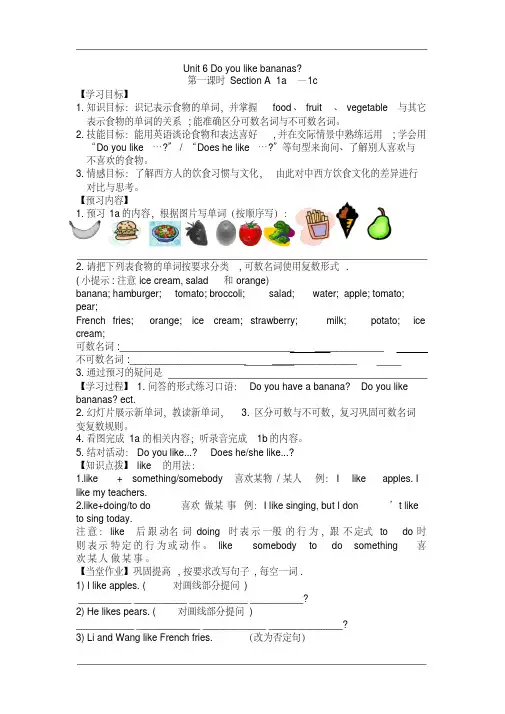
Unit 6 Do you like bananas?第一课时Section A 1a—1c【学习目标】1.知识目标:识记表示食物的单词,并掌握food、 fruit、 vegetable与其它表示食物的单词的关系;能准确区分可数名词与不可数名词。
2.技能目标:能用英语谈论食物和表达喜好,并在交际情景中熟练运用;学会用“Do you like…?” /“Does he like…?”等句型来询问、了解别人喜欢与不喜欢的食物。
3.情感目标:了解西方人的饮食习惯与文化,由此对中西方饮食文化的差异进行对比与思考。
【预习内容】1.预习1a的内容,根据图片写单词(按顺序写):2.请把下列表食物的单词按要求分类,可数名词使用复数形式.(小提示:注意ice cream, salad和orange)banana; hamburger; tomato; broccoli; salad; water; apple; tomato; pear;French fries; orange; ice cream; strawberry; milk; potato; ice cream;可数名词:_________________________________ _____________不可数名词:______________________ ________________3.通过预习的疑问是【学习过程】1.问答的形式练习口语:Do you have a banana? Do you like bananas? ect.2.幻灯片展示新单词,教读新单词,3.区分可数与不可数,复习巩固可数名词变复数规则。
4.看图完成1a的相关内容;听录音完成1b的内容。
5.结对活动:Do you like...? Does he/she like...?【知识点拨】like 的用法:1.like + something/somebody 喜欢某物/某人例:I like apples. I like my teachers.2.like+doing/to do喜欢做某事例:I like singing, but I don’t like to sing today.注意:like后跟动名词doing时表示一般的行为,跟不定式to do时则表示特定的行为或动作。
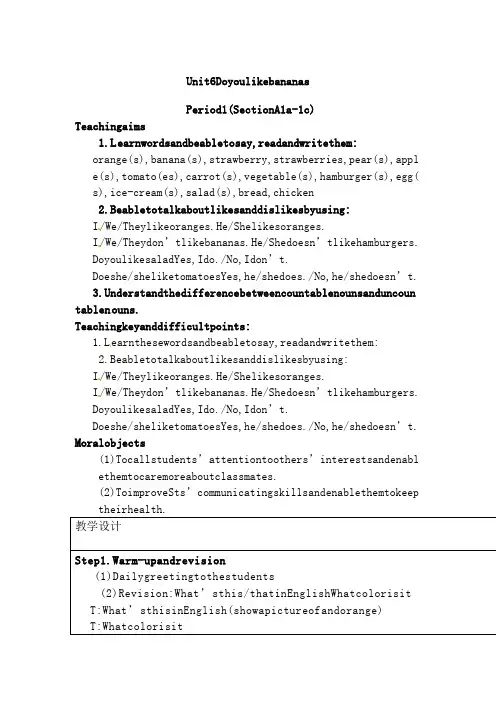
Unit6DoyoulikebananasPeriod1(SectionA1a-1c)Teachingaims1.Learnwordsandbeabletosay,readandwritethem:orange(s),banana(s),strawberry,strawberries,pear(s),appl e(s),tomato(es),carrot(s),vegetable(s),hamburger(s),egg( s),ice-cream(s),salad(s),bread,chicken2.Beabletotalkaboutlikesanddislikesbyusing:I/We/Theylikeoranges.He/Shelikesoranges.I/We/They don’tlike bananas.He/Shedoesn’tlikehamburgers.Doyoulikesalad Yes,Ido./No,Idon’t.Doeshe/sheliketomatoes Yes,he/shedoes./No,he/shedoesn’t.3.Understandthedifferencebetweencountablenounsanduncoun tablenouns.Teachingkeyanddifficultpoints:1.Learnthesewordsandbeabletosay,readandwritethem:2.Beabletotalkaboutlikesanddislikesbyusing:I/We/Theylikeoranges.He/Shelikesoranges.I/We/They don’tlike bananas.He/Shedoesn’tlikeh amburgers.Doyoulikesalad Yes,Ido./No,Idon’t.Doeshe/sheliketomatoes Yes,he/shedoes./No,he/shedoesn’t. Moralobjects(1)Tocallstudents’attentiontoothers’int erestsandenablethemtocaremoreaboutclassmates.(2)ToimproveSts’communicatingskillsandenablethemtokeepinEnglish(showapictureofsomemorewordsbyshowingpictures.GettheSstomakeaneffortt We/Theylike…We/Theydon’tlike…enandnumbertheconversations.(SectionA2a-2d) Teachingaims:1.Words&expressionsBirthday,dinner,week,thinkabout,food,sure,how /what about…Burger,vegetable,fruit,apple,then2.TargetlanguageIlikestrawberries,they’redelicious.Let’shav ethem.--Yes,Ilikethem,too./No,Idon’tlikethem.Ilikesalad,it’sdelicious.Doyoulikeit--Yes,Ido./No,Idon’tbutIlike icecream.Let’shave…Let’sthinkaboutthefood.AbilitygoalsEnablestudentstotalkaboutlikesanddislikes.LearningabilitygoalsHelpstudentslearnhowtotalkaboutlikesanddislik es.2.Listeningandspeakingskills.Moralobject:Learntokeephealthy.Teachingimportant/difficultpointsHowtotalkaboutlikesanddislikeswiththetargetla nguage.Teachingaims:Targetlanguage:DoyoulikesaladYes,Ido./No,Idon’t.DotheylikepearsYes,theydo./No,theydon’t.DoessheliketomatoesYes,shedoes./No,s hedoesn’t.Ilikeoranges,butIdon’tlike bananas.Welikerice.Wedon’tlikehamburgers.Helikesice-creambuthedoesn’tlike vegetables. Learningabilitygoals1.Helpthestudentslearnhowtotalkabouttheirlikesanddislikes.2.Helpthestudentsunderstandcountablenounanduncountablenoun. LearningdifficultandimportantpointsHowtotalkabouttheirfavoritefoods.Teachingaims:1.Words egg,carrot,rice,chicken,so.2.TargetlanguageDoesTomlikecarrotsYes,hedoesIlikecarrots!Abilitygoals1.Enablestudentstotalkaboutlikesanddislikesanddifferencebetweenfruitsandvegetables2.Listeningandspeakingskills.Moralobject:Learntokeephealthy.Teachingimportant/difficultpointsSstodiscussthelistsinpairsandw likes…and…Sallydoesn’tlike…(2a-2c)Teachingaims:1.Words:stareatwellhealthyreallyquestionwantbefat2.TargetlanguageWhatdoyoulikeforbreakfastDoyoulikehamburgersfordinnerAbilitygoals:1.EnablestudentstoreadthemagazinearticleaboutCindy’s favoritefoodsforthreemealsandwritefiv esentencesaboutCindy’seatinghabitsandretellC indy’seatinghabits2.Trainstudents’readingandwritingskills Moralgoals:Enablestudentscanformgoodeatinghabitsandkeeph ealthy.Teachingimportant/difficultpoints:1.Keywordsandsentences:2.Trainstudents’readingandwritingskills3.TalkaboutCindy’seatinghabitsusing“Whatdoyoulikefor….Ithink…WhatfruitdoyoulikeWhataboTeachingaims:1.Wordsapple,icecream,banana,broccoli,like,oranges,c arrot,breakfast,chicken,tomato,lunch,hamburge r,fruit,dinner,Frenchfries,vegetable,pear2.Targetlanguage:Ilike…Idon’tlike…Forbreakfast/lunch/dinn er,Ilike…Abilitygoals1.Enablestudentstolearntowritetheirfavoritefoodformeals2.LearningabilitygoalsHelpstudentslearnhowtowriteapassageabouttheyl ikeanddislikefordinner.Teachingimportant/difficultpoints:。

人教版七年级上册英语Unit6 Do you like bananas一. 教材分析人教版七年级上册英语Unit6 Do you like bananas主要讲述了关于喜好和食物的话题。
本节课的主要内容是让学生能够用英语询问和描述他们对不同食物的喜好。
教材通过简单的对话和词汇,帮助学生掌握基本的交际用语,并能够运用这些句子进行日常交流。
此外,本单元还引入了一般现在时态的用法,让学生能够用英语描述他们的日常喜好和习惯。
二. 学情分析在进入七年级上册时,学生们已经掌握了基本的英语语法和词汇知识,具备一定的听、说、读、写的能力。
然而,对于一般现在时态的用法和复杂的句子结构,他们可能还较为陌生。
因此,在教学过程中,需要注重引导学生理解和运用一般现在时态,并通过大量的练习和实际操作,让他们能够熟练运用该时态进行描述和交流。
三. 说教学目标1.知识目标:学生能够掌握一般现在时态的用法,并能够用英语询问和描述他们对不同食物的喜好。
2.能力目标:学生能够听懂、说出一般现在时态的句子,并能够运用该时态进行日常交流。
3.情感目标:通过小组合作和互动交流,学生能够增强自信心,提高团队合作意识。
四. 说教学重难点1.教学重点:一般现在时态的用法和食物词汇的掌握。
2.教学难点:一般现在时态的运用和食物词汇的灵活运用。
五. 说教学方法与手段1.教学方法:采用任务型教学法,通过小组合作、互动交流和实际操作,引导学生主动参与学习过程。
2.教学手段:利用多媒体教学资源,如图片、音频和视频,增加学生的学习兴趣和参与度。
六. 说教学过程1.导入:通过展示一些常见食物图片,引导学生谈论他们对食物的喜好。
2.新课呈现:引入一般现在时态的概念,并通过示例句子让学生理解一般现在时态的用法。
3.对话练习:让学生听录音或观看视频,模仿对话中的句子,并进行角色扮演。
4.小组活动:学生分组进行讨论,用英语询问和描述他们对食物的喜好。
5.巩固练习:通过完成练习题和互动游戏,让学生进一步巩固一般现在时态的用法。

Unit 6 Do you like bananas?Period 1一、教课目的:1.语言知识目标:1)能掌握以下词汇: banana, hamburger, tomato, ice-cream, salad, strawberry, pear,2)能掌握以下句型:① —② —Do you like salad?Does she/he like?— Yes, I do. / No, I don’t.— Yes, she/he does./ No, she/he doesn’t.③ — I like/I don’tlike④ — He/She likes / He/She doesn’tlike3) 能经过介绍食品学会咨询对方喜爱与不喜爱的食品。
2.感情态度价值观目标:经过学习西方食品文化,促进学生认识西方生活方式与文化,培育跨文化社交的意识。
二、教课重难点1.教课要点:1)学习并累积一些食品的词汇。
2)名词复数的使用。
3)动词 like 一般此刻时的各样句式及一般疑问句的一定、否认回答;2.教课难点:1)行为动词 like 的一般此刻时的用法;2)使用do 和does指引的一般疑问句的组成和使用。
三、教课过程I. New wordsAccording the pictures, learn the new words.II. Warming-upAsk some Ss questions:T:What’s that?S1: It’s _______.T:What are those? S1:They are _______.III. Presentation1. Show some pictures of food on the screen and learn the new words.(banana, hamburger, tomato, ice-cream, salad, strawberry, pear, milk, bread, birthday, food, burger, vegetable, fruit)2.Let Ss read and try to remember the new words.3.T: Let ’s look at the picture in 1a. Match the words with the things in thepicture. Then check the answers.IV. Pair work1.Read the conversations in 1b. Have Ss read after the teacher.2.Now let’s act out the conversations 1-3.(Ss work with their partner and act out the conversation 1-3.)3.Look at the picture and make more conversations using the words in 1a.4.Let some pairs act out their conversations.V. Reading1.According the pictures, learn the new words.2.Read the dialogue in 2d. Then answer the questions.Does John like hamburgers?3.Read the dialogue with your partner. Then role play the conversation.4.Practice the conversation with your partner.VII. Pair work1.Read the conversation in speech bubbles in 2b. Ask Ss to read after the teacher.2.Ss practice the conversations in pairs.3.Let some pairs act out the conversations.HomeworkCopy the new words in P99.教课反省period 2I. Language points一,学习新单词 ice-cream, salad, strawberry, pear, milk, bread, birthday, dinner, food,二,语言知识点tomatoes 西红柿tomatoes是 tomato 的复数形式。
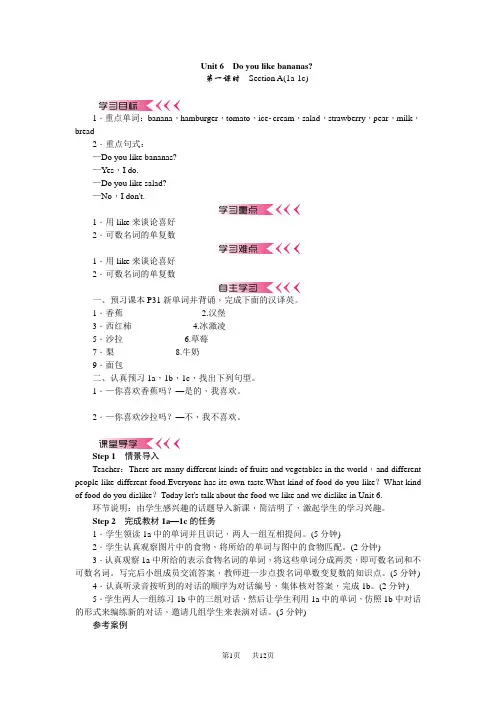
Unit 6Do you like bananas?第一课时Section A(1a-1c)1.重点单词:banana,hamburger,tomato,icecream,salad,strawberry,pear,milk,bread2.重点句式:—Do you like bananas?—Yes,I do.—Do you like salad?—No,I don't.1.用like来谈论喜好2.可数名词的单复数1.用like来谈论喜好2.可数名词的单复数一、预习课本P31新单词并背诵,完成下面的汉译英。
1.香蕉____________ 2.汉堡____________3.西红柿____________ 4.冰激凌__________5.沙拉____________ 6.草莓____________7.梨____________ 8.牛奶____________9.面包____________二、认真预习1a,1b,1c,找出下列句型。
1.—你喜欢香蕉吗?—是的,我喜欢。
________________________________________________________________________ 2.—你喜欢沙拉吗?—不,我不喜欢。
________________________________________________________________________Step 1情景导入Teacher:There are many different kinds of fruits and vegetables in the world,and different people like different food.Everyone has its own taste.What kind of food do you like?What kind of food do you dislike?Today let's talk about the food we like and we dislike in Unit 6.环节说明:由学生感兴趣的话题导入新课,简洁明了,激起学生的学习兴趣。
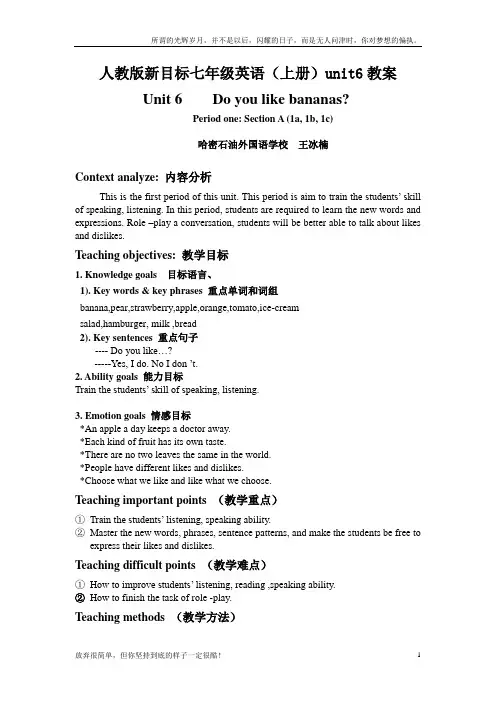
人教版新目标七年级英语(上册)unit6教案Unit 6 Do you like bananas?Period one: Section A (1a, 1b, 1c)哈密石油外国语学校王冰楠Context analyze: 内容分析This is the first period of this unit. This period is aim to train the students’ skill of speaking, listening. In this period, students are required to learn the new words and expressions. Role –play a conversation, students will be better able to talk about likes and dislikes.Teaching objectives: 教学目标1. Knowledge goals 目标语言、1). Key words & key phrases 重点单词和词组banana,pear,strawberry,apple,orange,tomato,ice-creamsalad,hamburger, milk ,bread2). Key sentences 重点句子---- Do you like…?-----Yes, I do. No I don ’t.2. Ability goals 能力目标Train the students’ skill of speaking, listening.3. Emotion goals 情感目标*An apple a day keeps a doctor away.*Each kind of fruit has its own taste.*There are no two leaves the same in the world.*People have different likes and dislikes.*Choose what we like and like what we choose.Teaching important points (教学重点)①Train the students’ listening, speaking ability.②Master the new words, phrases, sentence patterns, and make the students be free toexpress their likes and dislikes.Teaching difficult points (教学难点)①How to improve students’ listening, reading ,speaking ability.②How to finish the task of role -play.Teaching methods (教学方法)Pair-work , group-work and discussionTeaching aids 教学用具A computer and a projectorTeaching procedures & ways 教学过程Step 1 Class instruction practiceStep 2 Lead in and warm upStep 3 learn the new words(Show a picture of fridge, ask students to guess “What’s in my fridge? ”Students review and learn the names of the food.Then students try to classify them into two kinds: countable nouns and uncountable nouns. )Step 4 Enlarge the vocabulary and pronunciation practice . ( The students try to pronounce more new words. )(Get ready to the listening ,reading and speaking)Step 5 Listening practice(s tudents listen and number the conversations.)(Then students read after the tape. )Step 6 Pair-work(Students role play the conversation.) (Students talk about their likes and dislikes)Step7 Let’s sing and reviewStep8: Group work(Students work in a group of 6.They choose a topic and talk about their likes and dislikes.)HomeworkMake an interview to your family about the food and fruit. Find out about what they like and don’t like. Then write a letter to your friend.板书设计Unit 6 Do you like bananas?。
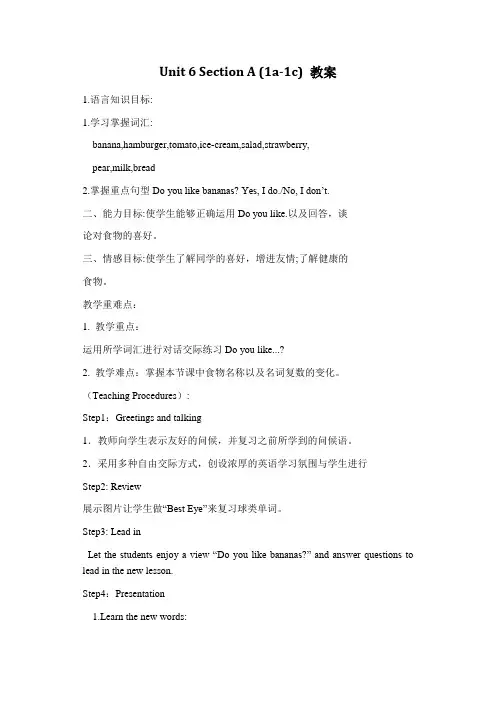
Unit 6 Section A (1a-1c) 教案1.语言知识目标:1.学习掌握词汇:banana,hamburger,tomato,ice-cream,salad,strawberry,pear,milk,bread2.掌握重点句型Do you like bananas? Yes, I do./No, I don’t.二、能力目标:使学生能够正确运用Do you like.以及回答,谈论对食物的喜好。
三、情感目标:使学生了解同学的喜好,增进友情;了解健康的食物。
教学重难点:1. 教学重点:运用所学词汇进行对话交际练习Do you like...?2. 教学难点:掌握本节课中食物名称以及名词复数的变化。
(Teaching Procedures):Step1:Greetings and talking1.教师向学生表示友好的问候,并复习之前所学到的问候语。
2.采用多种自由交际方式,创设浓厚的英语学习氛围与学生进行Step2: Review展示图片让学生做“Best Eye”来复习球类单词。
Step3: Lead inLet the students enjoy a view “Do you like bananas?” and answer questions to lead in the new lesson.Step4:Presentation1.Learn the new words:Show some pictures to learn new words of fruits and foods.2.Finish 1aLet students match the words with the things in the picture.3.Learn important sentences:展示图片进行师生互动操练重点句型:A: Do you / they like ... ?B: Yes, I/We/They do.No, I/We/They don’t.A: Does he/ she like ... ?B: Yes, he/she does.No, he/ she doesn’t.4.Pair work让学生两人一组操练重点句型:A: Do you / they like ... ?B: Yes, I/We/They do.No, I/We/They don’t.A: Does he/ she like ... ?B: Yes, he/she does.No, he/ she doesn’t.5.Finish 1bListen and number the conversations[1-3].6.Grammar:可数名词单复数变化方法讲解以及不可数名词的用法讲解7.Summary:教师带领学生回顾本节课所上的生词,句型和语法。

精选教课教课方案设计| Excellent teaching plan教师学科教课方案[ 20–20学年度第__学期]任教课科: _____________任教年级: _____________任教老师: _____________xx市实验学校精选教课教课方案设计| Excellent teaching plan《Do you like bananas? 》教课方案方案雷州市第二中学吴妲平课题名称《Do you like bananas?》科目英语年级七年级教课时间 1 课时( 45分钟)学习者分初一学生开朗好动可塑性大,他们对英语已经有了必定的基析础,学生在小学已经学习并掌握了一些单词以及表达喜恶的句型,并且已能用形容词等来表达自己的见解。
这个单元是以食品作为话题睁开喜恶的议论正好切合学生的表达欲念,食品这个话题很能惹起学生的兴趣,更能激发学生张口说英语的欲念。
但是学生在英语学习方面没有一个好的语言气氛,他们的知识面相对较窄,胆量广泛较小,不敢使用英语与人沟通,甚至有些孩子对英语学习自己就缺少兴趣。
这堂课我会用食品课件、图片及实物来激发学生的学习热忱,调换学生的参加踊跃性,为学生供给更直观的教课方法,让学生经过演练单词和句型来培育合作精神,学会尊重人与人之间的差别。
教课目的一、感情态度与价值观1.激发学生对食品的学习兴趣,激发学生学习英语的欲念和兴趣,使他们乐于参加各样英语实践活动。
2.经过对食品爱好的发问,能加强同学之间的互相认识和培育合作精神。
二、过程与方法1.以食品的词卡导入新课,以旧带新体现新知识2.运用词汇教课、句型教课及情形教课。
3.经过结对活动来锻炼学生的合作精神及口语能力。
4.做食品报告让学生学会总结与归纳,认识他人的爱勤学会尊敬他人,并且能锻炼学生的听闻读写能力。
三、知识与技术1.简单认识中西方饮食文化的差别,并用适合的方式表达自己的爱好,认识他人的爱好,尊敬人与人之间的差别。
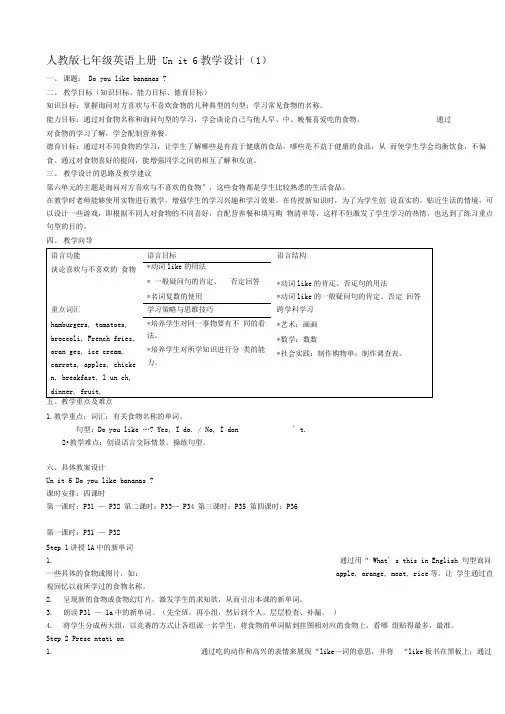
人教版七年级英语上册Un it 6教学设计(1)一、课题: Do you like bananas ?二、教学目标(知识目标、能力目标、德育目标)知识目标:掌握询问对方喜欢与不喜欢食物的几种典型的句型;学习常见食物的名称。
能力目标:通过对食物名称和询问句型的学习,学会谈论自己与他人早、中、晚餐喜爱吃的食物。
通过对食物的学习了解,学会配制营养餐。
德育目标:通过对不同食物的学习,让学生了解哪些是有益于健康的食品,哪些是不益于健康的食品,从而使学生学会均衡饮食,不偏食。
通过对食物喜好的提问,能增强同学之间的相互了解和友谊。
三、教学设计的思路及教学建议第六单元的主题是询问对方喜欢与不喜欢的食物”,这些食物都是学生比较熟悉的生活食品。
在教学时老师能够使用实物进行教学,增强学生的学习兴趣和学习效果。
在传授新知识时,为了为学生创设真实的,贴近生活的情境,可以设计一些游戏,即根据不同人对食物的不同喜好,自配营养餐和填写购物清单等,这样不但激发了学生学习的热情,也达到了练习重点句型的目的。
四、教学向导1.教学重点:词汇:有关食物名称的单词。
句型:Do you like …? Yes, I do. / No, I don ' t.2•教学难点:创设语言交际情景,操练句型。
六、具体教案设计Un it 6 Do you like bananas ?课时安排:四课时第一课时:P31 — P32 第二课时:P33— P34 第三课时:P35 第四课时:P36第一课时:P31 — P32Step 1讲授1A中的新单词1.通过用“ What' s this in English 句型询问一些具体的食物或图片,如:apple, orange, meat, rice等,让学生通过直观回忆以前所学过的食物名称。
2.呈现新的食物或食物幻灯片,激发学生的求知欲,从而引出本课的新单词。
3.朗读P31 — 1a中的新单词。
(先全班,再小组,然后到个人,层层检查、补漏。
《Unit 6 Do you like bananas?》单元教案Period 1 Section A 1a—2cⅠ.教学准备1.教师:录音机,磁带和课件。
2.学生:(1)在课前画一些食品的图片,通过查找资料,在图片下面标上英文名称。
(2)准备一张调查食物喜好的表格。
Ⅱ.教学目标1.单词:banana,hamburger,tomato,icecream,salad,strawberry,pear,milk,bread2.句型:—Do you like bananas?—Yes,I do./No,I don't.I like bananas.I don't like tomatoes.3.通过本课的学习,学生能够用英语互相讨论喜欢和不喜欢的食物。
4.讨论美食,享受生活美味,提倡健康、合理的饮食习惯。
Ⅲ.教学重点掌握关于食物的词汇。
Ⅳ.教学难点学会使用交际用语:—Do you like bananas?—Yes,I do./No,I don't.Ⅴ.教学步骤Step 1:Leadin建议1:用多媒体播放一首与食物水果有关的英文儿歌,目的是让学生轻松地投入到要学的内容中去,通过优美的歌曲,漂亮的画面,充分调动他们学习的积极性。
For example:Let's listen to a song.Do you like it?There are many kinds of food in this song.Today we are going to learn Unit 6:Do you like bananas?Section A 1a2c.建议2:建议教师与学生做一个猜猜看游戏,利用上单元学的表示球类的单词,猜猜老师和同学都喜欢什么。
目的是通过游戏复习所学的单词与句型,并引入新的要学的单词,激发学生的学习兴趣和求知欲。
For example:T:Let's play a game.You can guess “What sports do I like?” like this:Do you like soccer?Do you understand?Ss:Yes.T:Let's begin!S1:Do you like basketball?T:No.S2:Do you like baseball?T:No.S3:Do you like soccer?T:Yes.You are very cl ever.Let's give him a big hand....Then you know what sports I like.Now I want to tell you what food I li ke.I like bananas.Do you like bananas?Today we are going to learn Unit 6:Do you like bananas?Section A 1a2c.Step 2:Presentation建议1:通过让学生猜冰箱里有哪些食物导出新单词,同时让全体同学拼读每个单词,让个别同学将单词写到黑板上。
UNIT 6 DO YOU LIKE BANANAS?
(The first period section A 1z-1c)
Teaching aims (教学目标)
1.学会日常生活中食物水果的名称
2..学会谈论对食物水果的喜好
Lauguage points (语言栏)
要求掌握以下句式(1)Do you like┅Yes I do/No I don’t
(2)I like┅ I don’t like
要求掌握以下词汇knowledge tomatows broccoli French fries oranges
ice cream salad bananas strawberries garrots
Difficulties
(1) 可数名词和不可数名词
(2) 可数名词的复数形式
Teaching steps (教学步骤)
1.warning-up and revision (课堂热身和复习)
(1)Daily greeting to the students(日常问候)
(1)R evision(复习)I have┅Do you have ┅?
T: Good morning /afternoon/children
(showing a ) fruit basket
I have a fruit basket
Do you have a fruit basket
Ask the students to ask and answer using the pettern::
Do you have┅?
2. Guessing games
Taking away the fruit bastet and asking the students to guess: What’s in the basket? Using the sentence: Do you have┅? Present the names of all kindsof fruits and food 3. Showing a picture of fridge in the computer
Revise the names of food and fruit
Teach the new words of food and fruit
4. Practise
1a. match the words with the pictures
5. 2a. Listen and circle the food you hear
6. Show the picture again or take out an apple,
act out eating an apple delicious and say: I like apples for several times then take an egg, “I don’t like eggs” for several times, working a horrible face at them (Ask more questions about fruits and food )
7.Guessing game
Guess what my favourite food is, or ask some students to come to the front and guess what her/his favourite food is.
8. Fill in the chart
Ask the students to talk about their likes and dislikes in talking pairs 10. Listening
1b. Listen and number the conversation
11. Chant
12. Homework
Oral work:
Rcite the new words
Written work:
1. Copy the new words
2. Making up dialogues between you and your parents about
likes and dislikes。